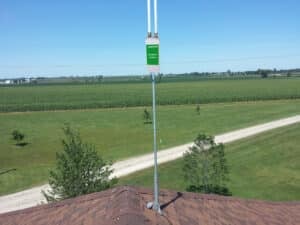It’s a fair question to ask about anything you haven’t done before – “What’s difficult about this?”

The AyrMesh system has been designed to work as easily as possible, and it has been designed for use by people with minimum networking and wireless skills. However, it still takes some mechanical skill to get the AyrMesh system working. We have learned over the years what is most likely to trip up a new AyrMesh user; these are the most common problems:
- Getting the radios up in the air. WiFi uses microwave radio to transmit data across the air, and microwaves propagate in what’s called a Fresnel zone. In order to work, the Fresnel zone between two radios (from Hub to Hub or Hub to your “client” device) needs to be at least 60% open. That means, if the Hubs are 2.5 miles apart, the Hub has to be at least 25 feet above ANY obstacles. So, if you have a 6′ rise in the land between the Hubs, and you’re growing corn that will be 10′ tall, you need to get the Hub AT LEAST 25+6+10=41 feet above the ground, which may not be easy. Trees, buildings, rocks, hills – all these obstruct the path between the Hubs and must be accommodated, sometimes by getting the Hub very high. Poles on top of buildings, telephone poles, flagpoles, and ham radio/commercial radio towers can all be useful.
- Using good Ethernet cables. Ethernet cables use four pairs of wires (eight wires total), two for data and two for power. If one of the power wires gets damaged, the Hub won’t start; if one of the data wires gets damaged, the Hub won’t pass data along the Ethernet cable. The sheathing on the cable and the insulation on the wires will fall off after a couple of years if the sheathing is not UV-resistant, and unshielded cables can cause data errors and dropouts. Good cables (and good installation of those cables) is critical.
- Bad location. AyrMesh is designed for use in a rural, “radio-quiet” environment. We have tested it in more populated areas where there are a lot of other WiFi (and other) signals nearby, and the effectiveness of the AyrMesh Hubs is diminished significantly. A large part of the “magic” behind the AyrMesh Hub’s long range is the use of high-gain antennas. High-gain antennas on the Hub “amplify” both the outgoing and the incoming signals, so it both “yells louder” and “listens better,” enabling it to “hear” signals from low-power devices from extraordinary distances. The problem with this, however, is that they also “hear” interference very well, reducing the range and speed of the Hub’s WiFi.
- Trying to do networking tricks. I have done plumbing, electrical, and a fair bit of wrenching, and IP networking is much simpler than any of those vocations. But there are rules, and you have to know how to use the tools at your disposal, ESPECIALLY routers. They’re small, inexpensive, and seemingly innocuous, but having more than one on a network can really screw things up. Fortunately, we have resources to help.
- Keeping the power supplies dry. The Hub itself is weatherproof, but the power supply is not, so the power supply needs to be kept dry, and drip loops must be used on cables to ensure water cannot travel down the cables to the power supply.
- The Hubs have to be secure. Every so often we’ll see a case where a Hub is not working well, and we find out that the Hub is leaning over 30 degrees, is completely upside-down, or has fallen off the pole. For the Hub to work properly, the antennas should be pointing straight up in the air – this maximizes their effectiveness and ensures that the Hub, which is sealed on top but has a hole underneath, remains dry inside.
The only networking consideration is to understand that the Hubs don’t do anything to the network traffic – they don’t route or filter, so everything connected to the AyrMesh network behaves as if connected directly to your router. The AyrMesh system can’t “break” your network when set up correctly, but, for instance, if you have two Hubs connected to your router, they’ll mesh and form a network loop. So, while the AyrMesh system won’t “break” your network, it also can’t “fix” anything you do to it. Network loops (one device connected to the network via two different interfaces, like a printer or camera connected via both Ethernet and WiFi) and IP address conflicts (two devices with the same IP address on the network) are the most common network problems. You can learn more about IP networks and router configuration on the Ayrstone blog.
That really covers the vast majority of pitfalls of the AyrMesh system – if you can apply a little energy and ingenuity, you can have a very capable wireless network across many, many acres with very little upkeep.
